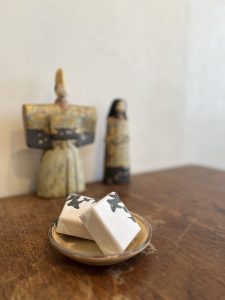最中(もなか)いただきました。(愛知県名古屋市千種区姫池通 骨董買取 古美術風光舎)
2025.02.18

本日、出張先のお客様より和菓子(もなか)をいただきました。美味しくいただきました!。ありがとうございました。
もなか、漢字で「最中」と書きますが、「最中」の餡には水飴が入っているため粘りがあり、とてもなめらかで舌になじみやすいように感じますよね。薄い皮も口に入れた瞬間、ふっと香ばしさが漂い、あのサクサクした食感はなんとも言えませんよね。いただいたものかも、さくさくとした皮と餡がとってもいいコンビでした。
それにしても「最中」とは不思議な名前ですよね。なぜ「さいちゅう」ではなく「もなか」なのか?
実はこの名前「中秋(ちゅうしゅう)の名月」を意味する「最中(もなか)の月」というお菓子の名が縮まってできたもののようなのですが、「最中」には「物事の中心」とか「盛りの時期」という意味があり、「最中の月」で「盛りの月」、つまり十五夜の満月「中秋の名月」をさしているようです。
これは平安時代の頃のお話でして、「最中」が今のような形になったのは江戸時代の半ば、江戸は吉原という所に店をかまえた竹村伊勢(たけむらいせ)という方が売り出した満月のような丸い煎餅からのようです。
煎餅といいましても、今の「最中」の皮に近いものだったらしく、その後この「最中の月」の間に餡をはさんだ最中饅頭が誕生し、次第に饅頭が省略され「最中」になったといわれています。現在のような「最中」は、明治から大正時代まで下り、型がつくられるようになってからなのですが、その大正時代には大変な人気となり、たいていの和菓子屋さんでつくられるまでに普及しました。
最中もこんな昔からのお菓子だなんて知らなかったのですが、そんなことを頭に入れながらもぐもぐもぐもぐ…。最中美味しかったです。
それではごきげんよう。
Today, we received Japanese sweets (monaka) from a customer on a business trip. We enjoyed it very much! Thank you very much.
Monaka” is written ‘monaka’ in Chinese characters, but the bean paste of ‘monaka’ is sticky due to the presence of mizuame (starch syrup), and it seems very smooth and easily blends with your tongue, doesn’t it? The thin crust also has a savory aroma the moment you put it in your mouth, and its crispy texture is indescribable, isn’t it? The one I had was also a very nice combination of crispy skin and sweet bean paste.
By the way, “monaka” is a strange name, isn’t it? Why “monaka” and not “saichu”?
Actually, the name “monaka” seems to be a contraction of the name of a confectionery called “monaka no tsuki,” which means “moon in the middle of autumn,” but “monaka” has the meaning of “the center of things” or “the peak of the season,” and “monaka no tsuki” means “full moon in the middle of autumn,” or the full moon of the 15th night. It seems to refer to the full moon on the fifteenth night of the month, the “Mid-Autumn Moon.
This is a story from the Heian period (794-1185), and it seems that “zaichu” took its current form in the middle of the Edo period (1603-1868), when a man named Takemura Ise, who had a store in Yoshiwara, Edo, started selling round rice crackers that looked like a full moon.
It is said that the sembe was similar to the skin of today’s “¡Èmonaka¡É. Later, the ¡Èmonaka manju¡É was created by inserting red bean paste between the ¡Èmonaka moons¡É, and gradually the word ¡Èmanju¡É was abbreviated to ¡Èmaichu¡É. It was not until the Meiji and Taisho eras (1912-1926) that the “monaka” as we know it today was made in a mold, but it became very popular during the Taisho era (1912-1926) and spread to the point where it was made in almost all Japanese confectionery shops.
I had no idea that “monaka” was such an old confectionery, but I munched on it with that in mind…. It was delicious.
Have a good day.
*****************
ご実家の整理やお片付けなどをされている方のご相談などが多くございます。
お片付けなどくれぐれもご無理のないようになさってくださいませ。
風光舎では古美術品や骨董品の他にも絵画や宝石、趣味のお品など様々なジャンルのものを買受しております。
お片付けをされていて、こういうものでもいいのかしらと迷われているものでも、どうぞお気軽にご相談下さいませ。
また風光舎は、出張買取も強化しております。ご近所はもちろん、愛知県内、岐阜県、三重県その他の県へも出張いたします。
まずは、お電話お待ちしております。
愛知県名古屋市千種区姫池通
骨董 買取【古美術 風光舎 名古屋店】
TEL052(734)8444
10:00-18:00 OPEN
#出張買取#骨董#古美術#骨董品#絵画#版画#茶道具#刀剣#彫刻

